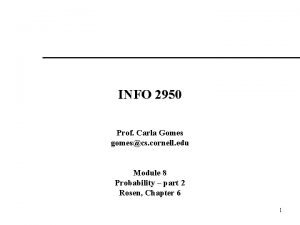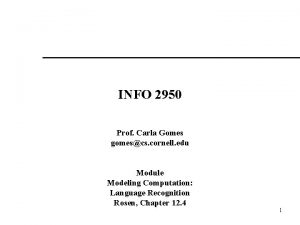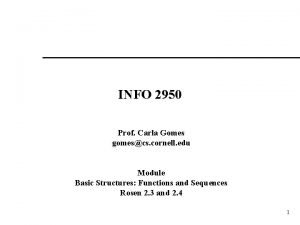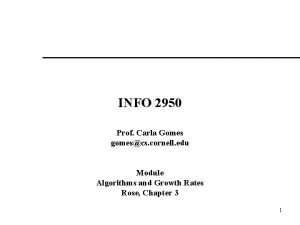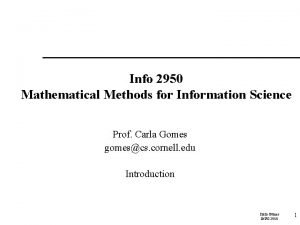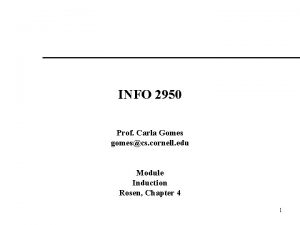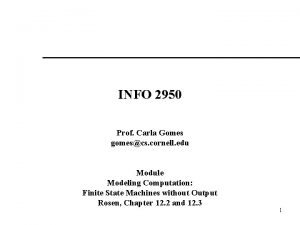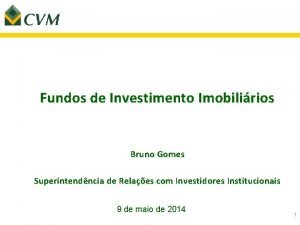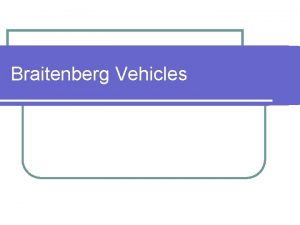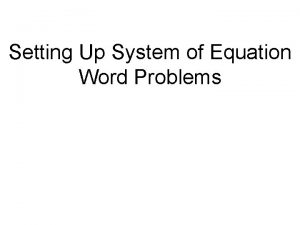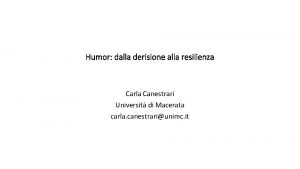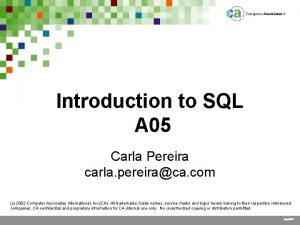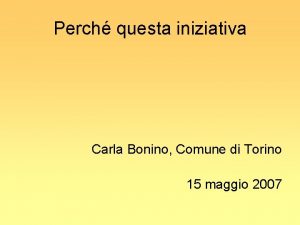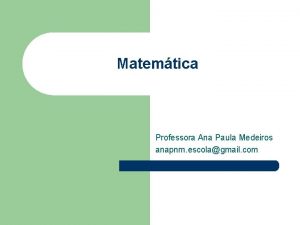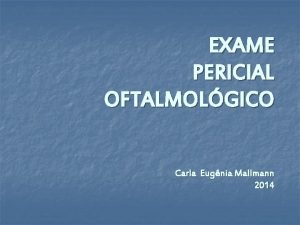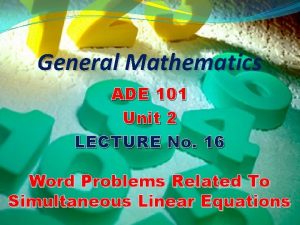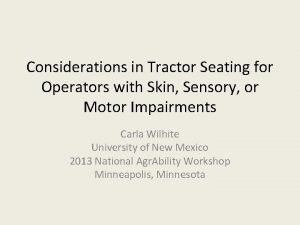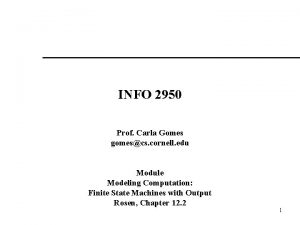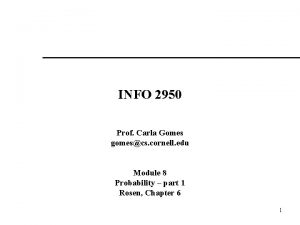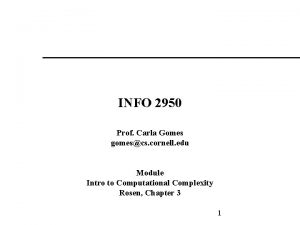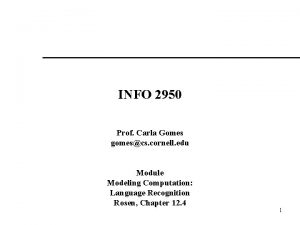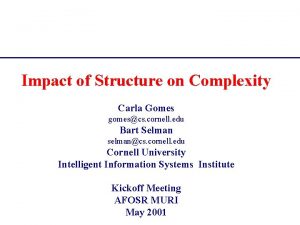INFO 2950 Prof Carla Gomes gomescs cornell edu
























































![Real Numbers How many real numbers are in interval [0, 1]? “Countably many! There’s Real Numbers How many real numbers are in interval [0, 1]? “Countably many! There’s](https://slidetodoc.com/presentation_image_h/158ad5d5343c1594586ff9816c1a32b1/image-57.jpg)
- Slides: 57

INFO 2950 Prof. Carla Gomes gomes@cs. cornell. edu Module Basic Structures: Functions and Sequences Rosen 2. 3 and 2. 4 1

Functions f(x) Suppose we have: x How do you describe the yellow function? What’s a function ? f(x) = -(1/2)x – 1/2

Functions More generally: B Definition: Given A and B, nonempty sets, a function f from A to B is an assignment of exactly one element of B to each element of A. We write f(a)=b if b is the element of B assigned by function f to the element a of A. If f is a function from A to B, we write f : A B. Note: Functions are also called mappings or transformations.

Functions A = {Michael, Toby , John , Chris , Brad } B = { Kathy, Carla, Mary} Let f: A B be defined as f(a) = mother(a). Michael Toby John Chris Brad A Kathy Carol Mary B 4

Functions More generally: B A - Domain of f B- Co-Domain of f f: R R, f(x) = -(1/2)x – 1/2 domain co-domain 5

a collection of Functions points! More formally: a function f : A B is a subset of Ax. B where a A, ! b B and <a, b> f. (note: ! for unique exists. ) B B a point! A A Why not? 6

Functions - image & preimage(S) For any set S A, image(S) = {b : a S, f(a) = b} So, image({Michael, Toby}) = {Kathy} image(A) = B - {Carol} Michael Toby John Chris Brad A image(John) = {Kathy} range of f image(A) Kathy Carol Mary B pre-image(Kathy) = {John, Toby, Michael}

Every b B has at most 1 preimage. Functions - injection A function f: A B is one-to-one (injective, an injection) if a, b, c, (f(a) = b f(c) = b) a = c Not one-to-one Michael Toby John Chris Brad Kathy Carol Mary 8

Every b B has at least 1 preimage. Functions - surjection A function f: A B is onto (surjective, a surjection) if b B, a A f(a) = b Not onto Michael Toby John Chris Brad Kathy Carol Mary 9

Functions – one-to-one-correspondence or bijection A function f: A B is bijective if it is one-to-one and onto. Every b B has exactly 1 preimage. Anna Mark John Paul Sarah Carol Jo Jo Martha Dawn Eve An important implication of this characteristic: The preimage (f-1) is a function! They are invertible. 10

Functions: inverse function Definition: Given f, a one-to-one correspondence from set A to set B, the inverse function of f is the function that assigns to an element b belonging to B the unique element a in A such that f(a)=b. The inverse function is denoted f-1 (b)=a, when f(a)=b. B 11

Functions - examples Suppose f: R+ R+, f(x) = x 2. Is f one-to-one? Is f onto? Is f bijective? yes yes This function is invertible. here 12

Functions - examples Suppose f: R R+, f(x) = x 2. Is f one-to-one? yes Is f onto? Is f bijective? no no This function is not invertible. 13

Functions - examples Suppose f: R R, f(x) = x 2. Is f one-to-one? no Is f onto? Is f bijective? no no 14


Functions - composition Let f: A B, and g: B C be functions. Then the composition of f and g is: (f o g)(x) = f(g(x)) “f composed with g” Note: (f o g) cannot be defined unless the range of g is a subset of the domain of f. 16

Example: Let f(x) = 2 x +3; g(x) = 3 x + 2; (f o g) (x) = f(3 x + 2) = 2 (3 x + 2 ) + 3 = 6 x + 7. (g o f ) (x) = g (2 x + 3) = 3 (2 x + 3) + 2 = 6 x + 11. As this example shows, (f o g) and (g o f) are not necessarily equal – i. e, the composition of functions is not commutative. 17

Note: (f -1 o f) (a) = f -1(f(a)) = f -1(b) = a. (f o f -1) (b) = f (f -1(b)) = f-(a) = b. Therefore (f-1 o f ) = IA and (f o f-1) = IB where IA and IB are the identity function on the sets A and B. (f -1) -1= f 18

Some important functions Absolute value: Domain R; Co-Domain = {0} R+ |x| = x -x if x ≥ 0 if x < 0 Ex: |-3| = 3; |3| = 3 Floor function (or greatest integer function): Domain = R; Co-Domain = Z x = largest integer not greater than x Ex: 3. 2 = 3; -2. 5 =-3 19

Some important functions Ceiling function: Domain = R; Co-Domain = Z x = smallest integer greater than or equal to x Ex: 3. 2 = 4; -2. 5 =-2 20


Some important functions Factorial function: Domain = Range = N n! = n (n-1)(n-2) …, 3 x 2 x 1 Ex: 5! = 5 x 4 x 3 x 2 x 1 = 120 Note: 0! = 1 by convention. 22

Mod (or remainder): Domain = N x N+ = {(m, n)| m N, n N+ } Co-domain Range = N m mod n = m - m/n n Ex: 8 mod 3 = 8 - 8/3 3 = 2 57 mod 12 = 9; Note: This function computes the remainder when m is divided by n. The name of this function is an abbreviation of m modulo n. Note also that this function is an example in which the domain of the function is a 2 -tuple. (*: also valid for negative numbers; but here we only consider natural numbers) 23

Exponential Function Exponential function: Domain = R+ x R = {(a, x)| a R+, x R } Co-domain Range = R+ f(x) = a x Note: a is a positive constant; x varies. Ex: f(n) = a n = a x a …, x a (n times) How do we define f(x) if x is not a positive integer? 24

Exponential function: How do we define f(x) if x is not a positive integer? Important properties of exponential functions: (1) a (x+y) = ax ay; (2) a 1 = a; (3) a 0 = 1 See: 25

We get: By similar arguments: Note: This determines ax for all x rational. x is irrational by continuity (we’ll skip “details”). 26

Some important functions: Logarithm Function Logarithm base a: Domain = R+ x R = {(a, x)| a R+, a>1, x R } Co-domain / Range = R y = log a (x) ay = x Ex: log 2 (8) =3; log 2 (16) =4; 3 < log 2 (15) <4. Key properties of the log function (they follow from those for exponential): 1. log a (1) = 0 (because a 0 =1) 2. log a (a) = 1 (because a 1 =a) 3. log a (xy) = log a (x) + log a (y) (similar arguments) 4. log a (xr) = r log a (x) 5. log a (1/x) = - log a (x) (note 1/x = x-1) 6. log b (x) = log a (x) / log a (b) 27

Examples: log 2 (1/4) = - log 2 (4) = - 2. log 2 (-4) undefined log 2 (210 35 )= log 2 (210) + log 2 (35 ) = 10 log 2 (2) + 5 log 2 (3 ) = 10 + 5 log 2 (3 ) 28

Limit Properties of Log Function As x gets large, log(x) grows without bound. But x grows MUCH faster than log(x)…more soon on growth rates. 29

Some important functions: Polynomials Polynomial function: Domain = usually R Co-domain Range = usually R Pn(x) = anxn + an-1 xn-1 + … + a 1 x 1 + a 0 n, a nonnegative integer is the degree of the polynomial; an 0 (so that the term anxn actually appears) (an, an-1, …, a 1, a 0) are the coefficients of the polynomial. Ex: y = P 1(x) = a 1 x 1 + a 0 linear function y = P 2(x) = a 2 x 2 + a 1 x 1 + a 0 quadratic polynomial or function 30

Exponentials grow MUCH faster than polynomials: We’ll talk more about growth rates in the next module…. 31

Sequences

Sequences Definition: A sequence {ai} is a function f: A N {0} S, where we write ai to indicate f(i). We call ai term I of the sequence. Examples: Sequence {ai}, where ai = i is just a 0 = 0, a 1 = 1, a 2 = 2, … Sequence {ai}, where ai = i 2 is just a 0 = 0, a 1 = 1, a 2 = 4, … Sequences of the form a 1, a 2, …, an are often used in computer science. (always check whether sequence starts at a 0 or a 1) These finite sequences are also called strings. The length of a string is the number of terms in the string. The empty string, denoted by , is the string that has no terms. 33

Geometric and Arithmetic Progressions Definition: A geometric progression is a sequence of the form The initial term a and the common ratio r are real numbers Definition: An arithmetic progression is a sequence of the form The initial term a and the common difference d are real numbers Note: An arithmetic progression is a discrete analogue of the linear function f(x) = dx + a 34

Notice differences in growth rate.

Summation The symbol (Greek letter sigma) is used to denote summation. i is the index of the summation, and the choice of letter i is arbitrary; the index of the summation runs through all integers, with its lower limit 1 and ending upper limit k. The limit: 36

The laws for arithmetic apply to summations Use associativity to separate the b terms from the a terms. Use distributivity to factor the c’s. 37

Summations you should know… What is S = 1 + 2 + 3 + … + n? (little) Gauss in 4 th grade. S = 1 + 2 + … + n Write the sum. S = n + n-1 + … + 1 Write it again. 2 s = n+1 + … + n+1 Add together. You get n copies of (n+1). But we’ve over added by a factor of 2. So just divide by 2. Why whole number? 38

Sum of first n odds. What is S = 1 + 3 + 5 + … + (2 n - 1)? Pleasantly simple expression 39

Sum of first n odds. What is S = 1 + 3 + 5 + … + (2 n - 1)? The visual way.

Geometric Series What is S = 1 + r 2 + … + rn Multiply by r Subtract the summations factor divide DONE!

What about: If r 1 this blows up. If r < 1 we can say something. Try r = ½.

Useful Summations

Infinite Cardinality How can we extend the notion of cardinality to infinite sets? Definition: Two sets A and B have the same cardinality if and only if there exists a bijection (or a one-to-one correspondence) between them, A ~ B. We split infinite sets into two groups: 1. Sets with the same cardinality as the set of natural numbers 2. Sets with different cardinality as the set of natural numbers 44

Infinite Cardinality Definition: A set is countable if it is finite or has the same cardinality as the set of positive integers. Definition: A set is uncountable if it is not countable. Definition: The cardinality of an infinite set S that is countable is denotes by א 0 (where א is aleph, the first letter of the Hebrew alphabet). We write |S| = א 0 and say that S has cardinality “aleph null”. Note: Georg Cantor defined the notion of cardinality and was the first to realize that infinite sets can have different cardinalities. א 0 is the cardinality of the natural numbers; the next larger cardinality is aleph-one א 1, then, א 2 and so on. 45

Infinite Cardinality: Odd Positive Integers Example: The set of odd positive integers is a countable set. 2 46

Infinite Cardinality: Odd Positive Integers Example: The set of odd positive integers is a countable set. Let’s define the function f, from Z+ to the set of odd positive numbers, f(n) = 2 n -1 We have to show that f is both one-to-one and onto. a) one-to-one Suppose f(n)= f(m) 2 n-1 = 2 m-1 n=m b) onto Suppose that t is an odd positive integer. Then t is 1 less than an even integer 2 k, where k is a natural number. hence t=2 k-1= f(k). 47

Infinite Cardinality: Odd Positive Integers Example: The set of odd positive integers is a countable set. 2 48

Infinite Cardinality: Integers Example: The set of integers is a countable set. Lets consider the sequence of all integers, starting with 0: 0, 1, -1, 2, -2, …. We can define this sequence as a function: f(n) = Show at home that it’s one-to-one and onto 0 1 2 -1 2 49

Infinite Cardinality: Rational Numbers Example: The set of positive rational numbers is a countable set. Hmm… 50

Infinite Cardinality: Rational Numbers Example: The set of positive rational numbers is a countable set Key aspect to list the rational numbers as a sequence – every positive number is the quotient p/q of two positive integers. Visualization of the proof. q= p+ 2 =3 p+q=4 p+q=5 p+q=6 q + p Since all positive rational numbers are listed once, the set of positive rational numbers is countable. 51

Uncountable Sets: Cantor's diagonal argument The set of all infinite sequences of zeros and ones is uncountable. Consider a sequence, For example: So in general we have: i. e. , sn, m is the mth element of the nth sequence on the list. 52

Uncountable Sets: Cantor's diagonal argument It is possible to build a sequence, say s 0, in such a way that its first element is different from the first element of the first sequence in the list, its second element is different from the second element of the second sequence in the list, and, in general, its nth element is different from the nth element of the nth sequence in the list. In other words, s 0, m will be 0 if sm, m is 1, and s 0, m will be 1 if sm, m is 0. 53

Uncountable Sets: Cantor's diagonal argument Note: the diagonal elements are highlighted, showing why this is called the diagonal argument The sequence s 0 is distinct from all the sequences in the list. Why? Let’s say that s 0 is identical to the 100 th sequence, therefore, s 0, 100=s 100, 100. In general, if it appeared as the nth sequence on the list, we would have s 0, n = sn, n, which, due to the construction of s 0, is impossible. 54

Uncountable Sets: Cantor's diagonal argument From this it follows that the set T, consisting of all infinite sequences of zeros and ones, cannot be put into a list s 1, s 2, s 3, . . . Otherwise, it would be possible by the above process to construct a sequence s 0 which would both be in T (because it is a sequence of 0's and 1's which is by the definition of T in T) and at the same time not in T (because we can deliberately construct it not to be in the list). T, containing all such sequences, must contain s 0, which is just such a sequence. But since s 0 does not appear anywhere on the list, T cannot contain s 0. Therefore T cannot be placed in one-to-one correspondence with the natural numbers. In other words, the set of infinite binary strings is uncountable. 55

Real Numbers Example; The set of real numbers is an uncountable set. Let’s assume that the set of real numbers is countable. Therefore any subset of it is also countable, in particular the interval [0, 1]. How many real numbers are in interval [0, 1]? 56
![Real Numbers How many real numbers are in interval 0 1 Countably many Theres Real Numbers How many real numbers are in interval [0, 1]? “Countably many! There’s](https://slidetodoc.com/presentation_image_h/158ad5d5343c1594586ff9816c1a32b1/image-57.jpg)
Real Numbers How many real numbers are in interval [0, 1]? “Countably many! There’s part of the list!” … 0. 4 3 2 9 0 1 3 2 9 8 4 2 0 3 9 … 0. 8 2 5 9 9 1 3 2 7 2 5 8 9 2 5 … 0. 9 2 5 3 9 1 5 9 7 4 5 0 6 2 1 … “Are you sure they’re all there? ” Counterexample: Use diagonalization to create a new number that differs in the ith position of the ith number by 1. 0. 5 3 6 … So, the reals are “uncountable. ” 57
 Info 2950
Info 2950 Carla p. gomes
Carla p. gomes Carla gomes cornell
Carla gomes cornell Info 2950 cornell
Info 2950 cornell Info 2950 cornell
Info 2950 cornell Info 2950 cornell
Info 2950 cornell Carla gomes
Carla gomes Carla p. gomes
Carla p. gomes Info 2950
Info 2950 Info 2950
Info 2950 Info 2950
Info 2950 Imieportfolio
Imieportfolio Ysi 2950
Ysi 2950 Cisco catalyst 2950 configuration
Cisco catalyst 2950 configuration Mirella gomes
Mirella gomes Mirella gomes de souza
Mirella gomes de souza Bruno gomes cvm
Bruno gomes cvm Dra mirella gastropediatra
Dra mirella gastropediatra Gomes leiteiro
Gomes leiteiro Lara gomes pais
Lara gomes pais Douro boatman
Douro boatman Filmes pornôs brasileirinhas
Filmes pornôs brasileirinhas Venocliseterapia
Venocliseterapia Dra mirella ginecologista
Dra mirella ginecologista Gabriel gomes da rocha
Gabriel gomes da rocha Nick gomes
Nick gomes Sí
Sí Edu.sharif.edu
Edu.sharif.edu Vehicles valentino braitenberg
Vehicles valentino braitenberg Carla licciardello
Carla licciardello At a college bookstore carla purchased
At a college bookstore carla purchased Carla canestrari unimc
Carla canestrari unimc Carla boudreaux
Carla boudreaux Carla buch
Carla buch Carla peer
Carla peer Porque dios nos creó únicos e irrepetibles
Porque dios nos creó únicos e irrepetibles Carla otten
Carla otten Carla tozzi
Carla tozzi Dra carla gikovate
Dra carla gikovate Carla bertossi
Carla bertossi Electircity
Electircity Synonym for comment
Synonym for comment Carla biggio
Carla biggio Carla bonino
Carla bonino Dra carla gikovate opiniões
Dra carla gikovate opiniões Ana paula e carla estudam matemática para um concurso
Ana paula e carla estudam matemática para um concurso Carla ippolito
Carla ippolito Campimetria de confrontação
Campimetria de confrontação Carla morsello
Carla morsello A turma da professora carla
A turma da professora carla Carla bruni surgery
Carla bruni surgery Carla carreira
Carla carreira Dr carla turner
Dr carla turner Timmy has 180 marbles
Timmy has 180 marbles Present perfect tense
Present perfect tense Carla wilhite
Carla wilhite Entre andres y carla tienen un total de 42 lapices
Entre andres y carla tienen un total de 42 lapices Carla maxted
Carla maxted
